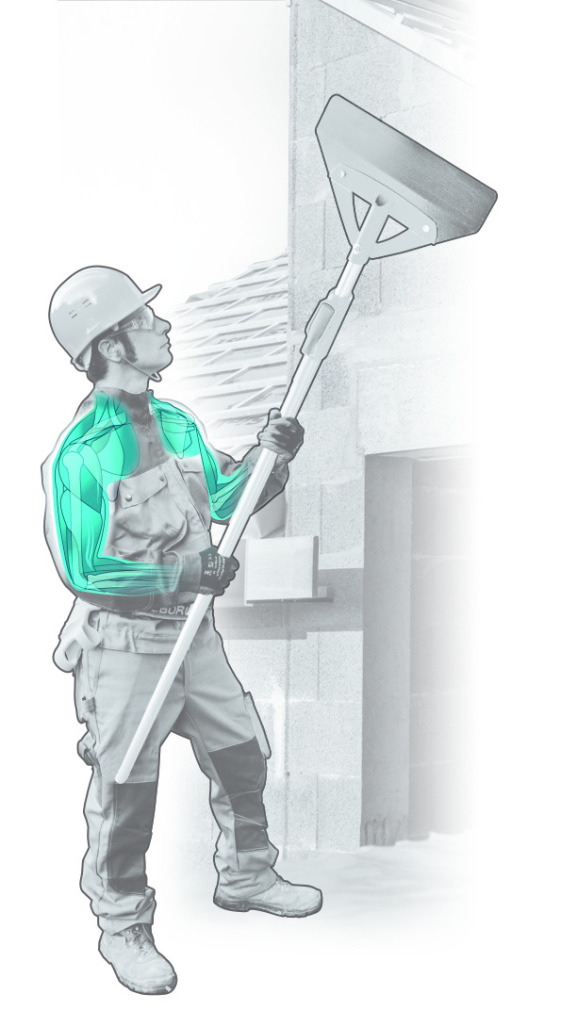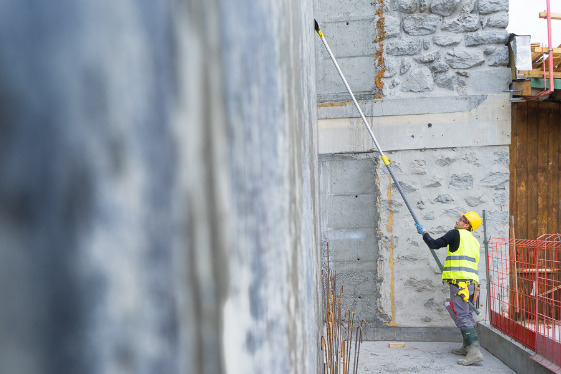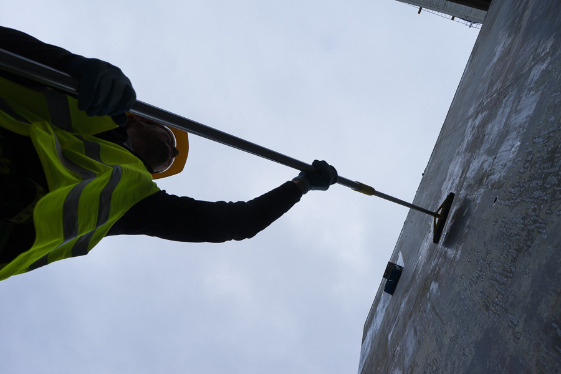How to prevent tiring positions on a work site using formed concrete construction ?
Arms above shoulder level, a tiring position for masons
On a work site using formed concrete construction the mason who scrapes concrete residues from the walls and forming panels is all too often in a situation where the arms must be lifted above shoulder level (or above the rotatory cuff) to carry out the work.
This is a tiring position because it strains the joints (extreme angles for articulations) and, if it is maintained for long periods, will lead to physical consequences: pain, tiredness and musculo-skeletal disorders.
Strain on the rotatory cuff leads to pain, loss of amplitude of movement and strength for the mason concerned by this pathology.
If the pathology is not treated correctly, the risk of making mistakes on the site increases due pain and tiredness felt by the mason which may lead to dangerous situations.
How
to eliminate the risk of this difficult position during masonry work ?
How to eliminate the risk of this difficult position during masonry work ?
In July 2016 in France, « tiring positions » was added to the list of health risk factors in the framework of the personal account for the prevention of physical strain, which came into effect from January 2015.
A tiring position was defined in the following way : « keeping arms in the air above shoulder height or crouching or kneeling or positions of twisting the upper body by 30 degrees or bending the upper body to 45 degrees ».
The only way to enable a mason to scrape without lifting arms above shoulder height is to install scaffolding. But this is not a satisfactory solution as he/she then runs another risk: working at heights..

The
Leborgne nanovib formwork scraper with telescopic handles : a longer reach for
less arduous work
The Leborgne nanovib formwork scraper with telescopic handles : a longer reach for less arduous work
The Leborgne nanovib formwork scraper has been produced to considerably reduce the risk factors relating to difficult positions. Designed for formed concrete construction, this tool with its telescopic handle (from 2m to 3.5m long) is three times longer than a traditional scraper. The only one of its kind on the market, it enables masons to clean concrete residues from double forming panels made of metal and from walls up to heights of 5 metres without having to hold the handle above the rotatory cuff (the main cause of MSD in the shoulder) and remain safely standing with both feet on the ground.

Other
advantages of the Leborgne nanovib formwork scraper
Other advantages of the Leborgne nanovib formwork scraper
The automatic handle with its blocking-release system without pin, allows rapid adjustment of the handle length by notches every 40cms.
The folded blade provides two angles for working, this makes it possible to choose the optimal direction to scrape fresh or dried laitances effectively. The edges of the blade are rounded to avoid scratching the surfaces which are scraped.
The extra-hard hardened steel blade of the scraper give high resistance, necessary to scrape and clean the forming panels and the walls. For greater robustness the tool socket is reinforced with two brackets and the 2mm thick, tempered aluminium tube is both light and strong.
Where to find the Leborgne nanovib formwork scraper ?
Find out about useful innovation at Leborgne

See other files
- How to prevent the risk of backache due to moving heavy loads on a construction site ?
- How to prevent the risk relating to mechanical vibrations on a work site ?
- How to prevent the risk of repetitive work on a site ?
- How to prevent the risk of noise from repeated impacts on the work site ?
- On a construction site how to prevent the risk of electrocution ?
